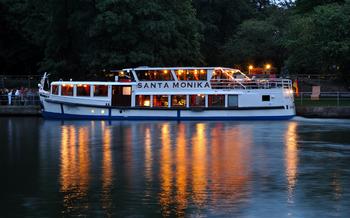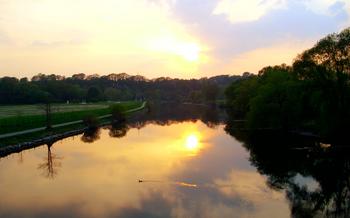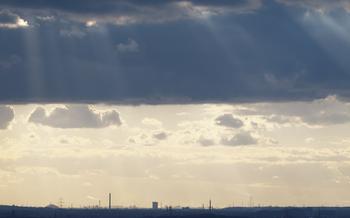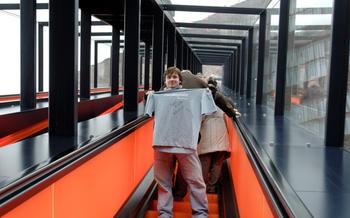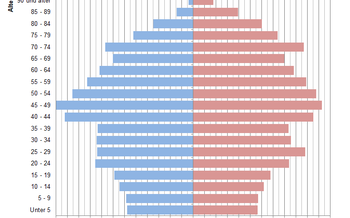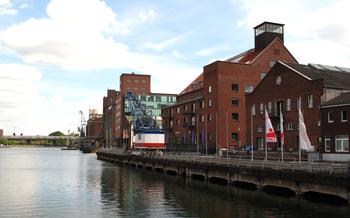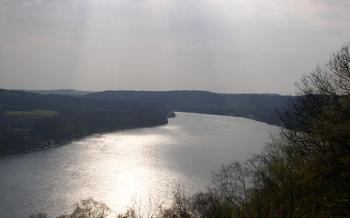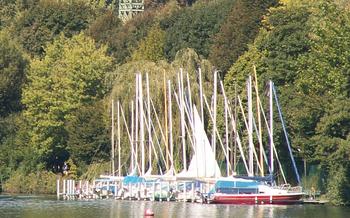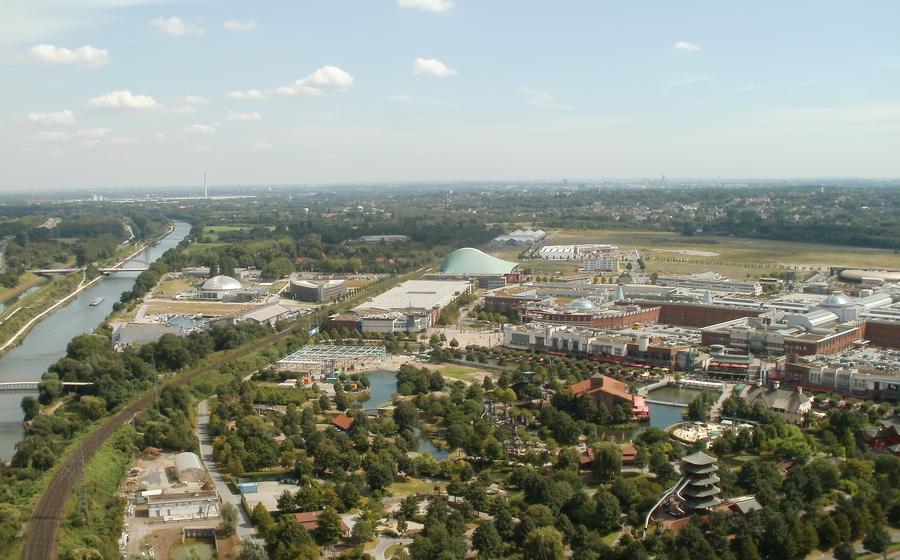
Oberhausen Gasometer
- A City with Industrial Heritage
- The Oberhausen Gasometer: A Landmark of Industrial Architecture
- Transformation into a Cultural Venue
- A Multifunctional Venue for Art and Culture
- The Exhibition Hall: A Unique Space for Art Installations
- The Gasometer's Observation Deck: Panoramic Views of the Ruhr Region
- The Gasometer's Restaurant: A Culinary Experience with a View
- Insider Tip:
- The Gasometer's Events and Festivals
- The Gasometer's Educational Programs
- The Gasometer's Accessibility and Transportation
- Tips for Visiting the Oberhausen Gasometer
- The Gasometer's Impact on the Ruhr Region
- The Oberhausen Gasometer and Sustainability
- The Gasometer in Popular Culture
- Insider Tip: Exploring the Gasometer's Hidden Corners
A City with Industrial Heritage
Essen, once a thriving industrial hub known for its coal mining and steel production, has undergone a remarkable transformation into a modern, vibrant city. The city's industrial heritage, however, remains deeply ingrained in its identity and is a source of pride for its residents. Essen's rich history, shaped by its industrial roots, has left an indelible mark on its architecture, culture, and economy. The city's transformation from an industrial powerhouse to a modern metropolis is a testament to its resilience and adaptability.
The Oberhausen Gasometer: A Landmark of Industrial Architecture
The Oberhausen Gasometer is a striking symbol of industrial architecture, standing tall in the heart of the Ruhr region in Germany. Built in 1929, this colossal structure was initially conceived as a coal storage facility for the nearby Gutehoffnungshütte, a major steel mill. Standing at a height of 115 meters, the gasometer has become an iconic landmark, embodying the industrial heritage of the Ruhr region. Its unique design features a cylindrical shape with a movable gas tank, making it a marvel of engineering and a testament to the region's rich industrial past.
The gasometer played a crucial role in the industrial development of the Ruhr region, serving as a storage facility for the coal gas used to power the steel mills and other industries in the area. Its massive size and ingenious design allowed for efficient storage and distribution of gas, ensuring a reliable supply of energy for the region's thriving industries. As the Ruhr region transitioned from its industrial roots to a modern economy, the gasometer's role diminished, leading to its closure as a coal storage facility in 198
Transformation into a Cultural Venue
With the decline of the coal and steel industries in the Ruhr region, the Oberhausen Gasometer faced an uncertain future. In the late 1980s, as the gasometer's function as a coal storage facility came to an end, the question arose of what to do with this massive industrial structure. Demolition was considered, but the gasometer's unique architecture and historical significance made it a strong candidate for preservation.
In 1991, a decision was made to redevelop the gasometer into a cultural venue. This ambitious project involved converting the former coal storage facility into a multifunctional space for art, culture, and events. The challenges were significant. The gasometer's vast interior had to be adapted to its new purpose, while preserving its industrial character. The unique cylindrical shape and lack of windows posed acoustical and lighting challenges that needed to be addressed.
Despite these challenges, the redevelopment project was a resounding success. In 1994, the Oberhausen Gasometer opened its doors as a cultural venue, showcasing a diverse range of exhibitions, concerts, and events. The transformation of the gasometer from an industrial relic to a vibrant cultural space was a pioneering achievement, setting a precedent for the adaptive reuse of industrial heritage sites across Germany and beyond.
A Multifunctional Venue for Art and Culture
The Oberhausen Gasometer has undergone a remarkable transformation from a coal storage facility to a vibrant cultural venue. Today, it stands as a symbol of the Ruhr region's industrial heritage while simultaneously promoting arts and culture in the region. The gasometer's unique architecture and vast interior space make it a versatile venue for a wide range of cultural events and exhibitions.
The gasometer's main attraction is its vast exhibition hall, which offers a unique and awe-inspiring setting for art installations and exhibitions. The hall's immense size and height create a sense of grandeur and provide ample space for large-scale artworks and immersive installations. Over the years, the hall has hosted a diverse range of exhibitions, from contemporary art and photography to historical artifacts and industrial machinery.
In addition to the exhibition hall, the gasometer also features a variety of other spaces for cultural events and activities. The former coal bunkers have been converted into smaller exhibition spaces, studios, and workshops, providing opportunities for artists and creative professionals to showcase their work and engage with the public. The gasometer's expansive rooftop terrace offers a panoramic view of the Ruhr region and serves as a venue for outdoor concerts, theater performances, and film screenings during the summer months.
The Oberhausen Gasometer's diverse cultural programming attracts a wide range of visitors, from art enthusiasts and history buffs to families and tourists. It has become a hub for arts and culture in the Ruhr region, contributing to the revitalization of the region's cultural landscape and promoting a sense of community and creativity among its residents.
The Exhibition Hall: A Unique Space for Art Installations
The Oberhausen Gasometer's exhibition hall is a remarkable space that has played host to a diverse range of art installations and exhibitions. With a diameter of 68 meters and a height of 117 meters, the hall offers an unparalleled canvas for artists to showcase their work. The sheer size and dimensions of the space create a sense of awe and wonder, allowing visitors to experience art on a truly grand scale.
Beyond its size, the exhibition hall is also renowned for its unique atmosphere and acoustics. The vast, open space allows for immersive installations that envelop visitors in a multisensory experience. The acoustics of the hall are equally impressive, creating an intimate and resonant environment that enhances the impact of sound-based installations.
Over the years, the exhibition hall has hosted a wide range of notable art installations and exhibitions. These have included large-scale sculptures, video projections, light displays, and interactive installations that push the boundaries of artistic expression. Some of the most memorable exhibitions have included "The Art of the Brick" by Nathan Sawaya, which featured intricate sculptures made entirely from Lego bricks, and "Lumen | Space | Time" by Ólafur Elíasson, which transformed the hall into a mesmerizing realm of light and color.
The Gasometer's Observation Deck: Panoramic Views of the Ruhr Region
The Oberhausen Gasometer's observation deck is situated at an impressive height, offering visitors unparalleled views of the Ruhr region. Accessible by a panoramic elevator, the deck provides a 360-degree perspective, allowing visitors to soak in the region's vast industrial landscapes, verdant green spaces, and shimmering waterways. On a clear day, the view extends as far as the Düsseldorf skyline, with its iconic skyscrapers piercing the horizon.
The experience of visiting the observation deck is truly breathtaking. As the elevator ascends, visitors are treated to a mesmerizing journey through the gasometer's cavernous interior, with its intricate steel framework and industrial charm. Once at the top, they are greeted by a panorama that unfolds like a living masterpiece. The Ruhr region's rich tapestry of industry, nature, and urban development is laid out before them, creating a sense of awe and wonder.
Whether you're a local resident or a tourist, the Gasometer's observation deck is a must-visit attraction. It offers a unique opportunity to witness the transformation of the Ruhr region from an industrial heartland to a vibrant cultural hub. The panoramic views are not just a feast for the eyes, but also a reminder of the region's rich history and its promising future.
The Gasometer's Restaurant: A Culinary Experience with a View
The Gasometer's restaurant, located on the 11th floor, offers a unique dining experience with panoramic views of the Ruhr region. The restaurant's floor-to-ceiling windows provide stunning vistas of the surrounding landscape, including the city of Oberhausen, the Rhine-Herne Canal, and the lush greenery of the Ruhrgebiet.
The menu features a diverse selection of culinary delights, ranging from regional specialties to international cuisine. Diners can indulge in dishes prepared with fresh, local ingredients, showcasing the culinary traditions of the Ruhr region. The restaurant also offers an extensive wine list, featuring a variety of vintages from around the world, carefully selected to complement the menu.
The ambiance of the restaurant is elegant and sophisticated, with a modern design that complements the industrial heritage of the gasometer. The warm lighting, comfortable seating, and attentive service create a welcoming and memorable dining experience. Whether you're celebrating a special occasion or simply seeking a unique culinary adventure, the Gasometer's restaurant offers an unforgettable experience.
Insider Tip:
For a truly unforgettable dining experience, reserve a table by the window during sunset. The golden hues of the sky, reflecting on the glass facade of the gasometer, create a magical ambiance that enhances the already stunning views.
The Gasometer's Events and Festivals
The Oberhausen Gasometer is not only a venue for exhibitions and art installations but also hosts a variety of events and festivals throughout the year, making it a vibrant cultural hub in the Ruhr region. These events range from music concerts and theater performances to food festivals and cultural celebrations, attracting a diverse audience from across the region and beyond.
One of the highlights of the gasometer's event calendar is the annual Ruhrtriennale, an international arts festival that showcases a diverse range of contemporary performing arts, including theater, dance, music, and performance art. The festival takes place in various venues across the Ruhr region, with the gasometer serving as one of its main stages.
The gasometer's unique atmosphere and stunning views also make it an ideal location for special events and celebrations. From corporate functions and private parties to weddings and anniversaries, the gasometer offers a unique and memorable backdrop for any occasion.
With its diverse range of events and festivals, the Oberhausen Gasometer is a true cultural melting pot, bringing together people from all walks of life to celebrate art, culture, and community in a truly unique and inspiring setting.
The Gasometer's Educational Programs
The Oberhausen Gasometer is not just a cultural venue; it also serves as an educational hub for the Ruhr region. The gasometer offers a variety of educational programs aimed at promoting STEM education and industrial heritage awareness, particularly among younger generations. These programs are designed to engage students and provide them with hands-on learning experiences that foster their curiosity and creativity.
The gasometer's educational programs cover a wide range of topics related to science, technology, engineering, and mathematics (STEM). Students can participate in workshops, guided tours, and interactive exhibitions that explore the history of the gasometer, its industrial significance, and its transformation into a cultural landmark. They can learn about the principles of gas production and storage, the engineering feats involved in constructing the gasometer, and the innovative technologies used in its redevelopment as a cultural venue.
The gasometer's educational programs are also designed to promote sustainability and environmental awareness. Students can learn about the gasometer's commitment to sustainability, its use of renewable energy sources, and its initiatives to reduce its carbon footprint. They can also participate in workshops and activities that focus on environmental issues such as climate change, energy conservation, and waste reduction.
The gasometer's educational programs are an important part of its mission to engage the community and promote cultural and scientific literacy in the Ruhr region. By providing students with unique learning experiences that foster their curiosity and creativity, the gasometer is helping to shape the next generation of innovators and leaders in the region.
The Gasometer's Accessibility and Transportation
The Oberhausen Gasometer is conveniently located in the heart of the Ruhr region, making it easily accessible by various modes of transportation. The gasometer is situated adjacent to the Oberhausen Hauptbahnhof, the city's main train station, providing direct connections to major cities across Germany and beyond. For those arriving by car, the gasometer is accessible via the A3 and A42 motorways, with ample parking available nearby. The gasometer is also well-connected by public transportation, with several bus and tram lines stopping right outside the venue. Visitors with disabilities can take advantage of designated parking spaces and wheelchair-accessible entrances and elevators, ensuring a seamless and enjoyable visit.
Tips for Visiting the Oberhausen Gasometer
To make the most of your visit to the Oberhausen Gasometer, consider the following tips:
-
Plan your visit: Check the gasometer's website for information on current exhibitions, events, and opening hours. Plan your visit accordingly to avoid disappointment.
-
Explore the surrounding area: The gasometer is located in the vibrant district of Oberhausen-Mitte, which offers a variety of attractions, including the Centro shopping mall, the Sea Life Centre, and the Ruhr Museum.
-
Take the guided tour: Guided tours of the gasometer are available in English and German. These tours provide insights into the history, architecture, and transformation of the gasometer, making your visit even more enriching.
-
Enjoy the views: The observation deck offers breathtaking panoramic views of the Ruhr region. Take your time to soak in the stunning vistas and capture some memorable photos.
-
Dine with a view: The gasometer's restaurant, located on the 117-meter-high observation deck, offers a unique dining experience with panoramic views of the Ruhr region. Reservations are recommended, especially for special occasions.
The Gasometer's Impact on the Ruhr Region
The Oberhausen Gasometer has played a significant role in revitalizing the Ruhr region. As a symbol of the region's industrial heritage, the gasometer has attracted tourists and visitors from around the world, contributing to the region's economy. By transforming the gasometer into a cultural venue, the city of Oberhausen has created a new destination for art and culture enthusiasts, attracting both local and international audiences. The gasometer's success has also inspired other former industrial sites in the Ruhr region to be redeveloped into cultural and creative spaces, contributing to the region's ongoing transformation from an industrial powerhouse to a vibrant cultural hub.
The gasometer's redevelopment has also had a positive impact on the surrounding area. The Landschaftspark Duisburg-Nord, a former steel mill that has been transformed into a public park, is located just a short distance from the gasometer. The proximity of these two iconic landmarks has created a unique cultural and recreational destination, attracting visitors from throughout the Ruhr region and beyond. The success of the gasometer and the Landschaftspark has demonstrated the potential of industrial heritage sites to be transformed into vibrant public spaces, contributing to the overall revitalization of the Ruhr region.
The Oberhausen Gasometer and Sustainability
The Oberhausen Gasometer stands as a testament to the harmonious coexistence of industrial heritage and sustainable practices. The venue's commitment to sustainability is evident in its adoption of renewable energy sources and green technologies. Solar panels adorn the gasometer's exterior, capturing the sun's energy to generate electricity for the venue's operations. Geothermal energy, harnessed from the earth's core, provides heating and cooling for the gasometer, reducing its reliance on fossil fuels.
The gasometer's commitment to sustainability extends beyond energy efficiency. Water conservation measures, such as rainwater harvesting and greywater recycling, are implemented to minimize the venue's water footprint. Sustainable materials and construction techniques are prioritized during renovation and expansion projects, ensuring the gasometer's longevity while minimizing its environmental impact.
The gasometer's commitment to sustainability extends beyond its own operations. The venue actively promotes environmental awareness and education through its exhibitions, events, and educational programs. Interactive displays, workshops, and lectures showcase the importance of sustainability and encourage visitors to adopt eco-friendly practices in their own lives.
The Oberhausen Gasometer serves as an inspiring example of how industrial heritage can be preserved and celebrated while embracing sustainable principles. Its commitment to sustainability demonstrates the venue's dedication to creating a greener future for the Ruhr region and beyond.
The Gasometer in Popular Culture
The Oberhausen Gasometer's striking appearance and unique history have made it a popular subject in popular culture. It has been featured in numerous films, television shows, and music videos, often serving as a backdrop for stories set in the Ruhr region's industrial past or present-day urban renewal efforts. The gasometer's distinctive silhouette and towering presence have also made it a recognizable landmark in the region, symbolizing both its industrial heritage and its transformation into a modern cultural hub.
One notable example of the gasometer's appearance in popular culture is the German film "Das Wunder von Bern" (2003), which tells the story of the German national football team's victory in the 1954 World Cup. The gasometer is prominently featured in several scenes, as it served as a backdrop for the team's training ground. The film's depiction of the gasometer as a symbol of hope and renewal resonated with audiences, further cementing its status as a cultural icon of the Ruhr region.
The gasometer has also been featured in music videos by artists such as Rammstein and Die Ärzte, who have used its striking visuals to create memorable and visually stunning music videos. The gasometer's unique atmosphere and industrial aesthetic have made it a popular choice for filmmakers and musicians seeking to capture the essence of the Ruhr region's transformation from an industrial powerhouse to a modern cultural hub.
Insider Tip: Exploring the Gasometer's Hidden Corners
Beyond the main attractions of the Oberhausen Gasometer, there are hidden corners and lesser-known spots that offer unique perspectives and experiences. For those willing to explore, the gasometer reveals its secrets.
Venture to the rooftop of the gasometer to discover a hidden terrace that offers panoramic views of the Ruhr region from a different angle. This secluded spot is perfect for escaping the crowds and enjoying a moment of tranquility while taking in the stunning scenery.
Another hidden gem is the gasometer's former coal bunkers. These underground chambers, once used to store coal for the gas production process, have been repurposed into atmospheric event spaces. Today, they host intimate concerts, art installations, and other exclusive events, creating a unique and immersive experience for visitors.
For those interested in the gasometer's industrial heritage, a guided tour of the former production facilities is a must. This behind-the-scenes tour provides a glimpse into the inner workings of the gasometer and its role in the industrial development of the Ruhr region.
Finally, don't miss the opportunity to explore the gasometer's surroundings. The adjacent Landschaftspark Duisburg-Nord, a former industrial site transformed into a sprawling park, offers a picturesque setting for a stroll or bike ride. Discover the park's unique sculptures, playgrounds, and remnants of its industrial past, creating a harmonious blend of nature and history.
Exploring the hidden corners of the Oberhausen Gasometer is a rewarding experience that unveils the gasometer's rich history, unique features, and unexpected perspectives. Whether you're an art enthusiast, a history buff, or simply looking for a hidden gem, the gasometer offers endless opportunities to discover and explore.
